Are you having trouble with your German Shepherd’s aggressive behavior during grooming? German Shepherds are super smart and loving, but sometimes they can get a little too fierce when you try to groom them.
As a responsible GSD owner, you want to maintain your dog’s appearance, but how do you groom a German Shepherd that becomes aggressive during grooming?
Grooming an aggressive German Shepherd requires patience, consistency, and understanding. By gradually introducing grooming activities and using positive reinforcement, you can help your dog overcome their aggression while keeping them looking their best.
In this blog post, we’ll provide you with expert tips and techniques to manage your German Shepherd’s aggression during grooming.
From understanding body language to creating a comfortable grooming environment, we’ll cover everything you need to know.
So, let’s start grooming your aggressive GSD!
Contents
- 1 Why German Shepherds Get Aggressive During Grooming?
- 2 How To Prepare An Aggressive German Shepherd For Grooming?
- 3 Step-by-Step Guide To Grooming An Aggressive German Shepherd
- 4 How To Handle Aggression During Grooming?
- 5 How Do Groomers Deal With Aggressive German Shepherds?
- 6 Conclusion:
- 7 Frequently Asked Questions:
- 7.1 How to groom an aggressive German Shepherd’s face?
- 7.2 How to groom an aggressive German Shepherd at home?
- 7.3 How to groom a German Shepherd that bites?
- 7.4 How to cut an aggressive German Shepherd’s nails?
- 7.5 How do I immobilize my German Shepherd for grooming?
- 7.6 Can grooming help reduce aggression in German Shepherds?
- 7.7 Resources Used For Research:
Why German Shepherds Get Aggressive During Grooming?
Before we dive into the grooming process, it’s essential to understand why your German Shepherd might be aggressive during the process.
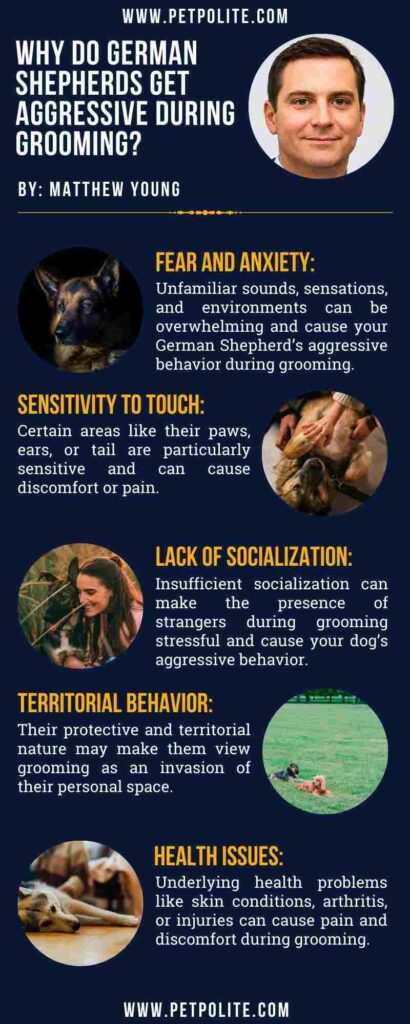
Here are some reasons that can be responsible:
1. Fear and Anxiety:
Many German Shepherds become aggressive during grooming due to fear and anxiety.
The grooming process involves unfamiliar sounds, sensations, and environments, which can be overwhelming.
Past negative experiences, such as painful grooming sessions or rough handling, can also contribute to their fear.
2. Sensitivity to Touch:
German Shepherds can be sensitive to touch, especially in certain areas like their paws, ears, or tails.
This sensitivity can cause discomfort or pain, leading to aggressive reactions during grooming.
3. Lack of Socialization:
Dogs that haven’t been socialized may not be used to being touched or being around strangers.
This can make grooming a scary and stressful experience, which can cause them to become aggressive.
4. Territorial Behavior:
German Shepherds are known for their protective and territorial nature.
They may view grooming as an invasion of their personal space, especially if they feel threatened or restrained.
5. Health Issues:
Underlying health issues, such as skin conditions, arthritis, or injuries, can cause pain and discomfort during grooming.
This physical discomfort can trigger aggressive behavior as a way to protect themselves.

“Dogs may become aggressive during grooming due to pain from current or past medical issues.”
Source: WagWalking.com
How To Prepare An Aggressive German Shepherd For Grooming?
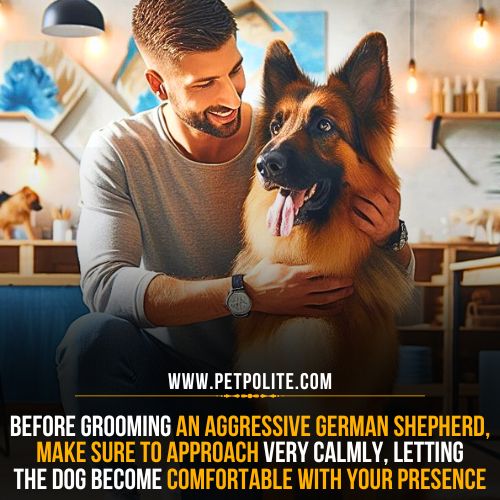

1. Create a Calm Environment:
Choose a quiet, comfortable space for grooming. Ensure that the area is free from distractions and loud noises.
A calm environment helps reduce your dog’s anxiety and aggression.
You can also play soft music or use calming scents like lavender to help soothe your dog.
2. Get the Right Tools:
Make sure you have all the necessary grooming tools ready before you start. This includes:
- Slicker brush or Pin brush
- Undercoat Rake
- Nail clippers or grinders
- Dog-friendly shampoo and conditioner
- Towels
Having everything within reach will help the grooming process go smoothly without unnecessary interruptions.
3. Introduce the Tools Gradually:
Allow your dog to sniff and become familiar with the grooming tools before you start. This helps reduce fear and anxiety.




“Let your pup get to know the grooming tools. Let them sniff, lick, and explore before you start using them.”
Source: HoundTherapy.com
4. Use Positive Reinforcement:
Reward your dog with treats and praise when he behaves well. This will help it associate grooming with good things.
Have treats ready before you start grooming.
5. Use Muzzle If Necessary:
If your German Shepherd is very aggressive, you might need to use a muzzle. This can keep both you and your dog safe.
Make sure the muzzle fits well and is comfortable for your dog.
Step-by-Step Guide To Grooming An Aggressive German Shepherd
Grooming an aggressive German Shepherd can be challenging, but with patience, the right tools, and techniques, you can make the process smoother and safer for both you and your dog.
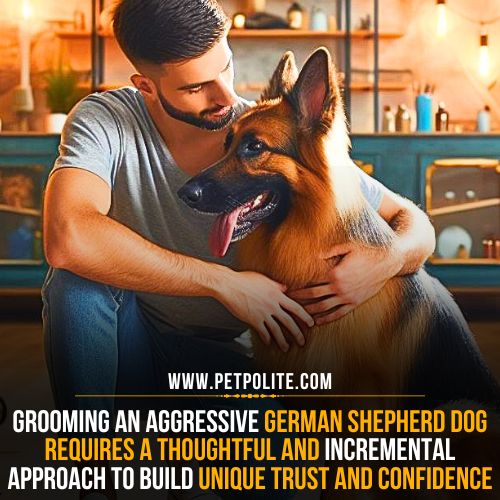

Follow these steps to groom your aggressive German Shepherd effectively:
1. Assess Your Dog’s Behavior:
Before you start grooming, observe your dog’s behavior to understand its triggers and levels of aggression.
Look for signs like growling, baring teeth, or stiff body posture. Knowing what makes your dog uncomfortable can help you avoid those triggers during grooming.
2. Calm Your Dog:
Spend a few minutes calming your dog before you start grooming. You can:
- Use soothing words and gentle petting
- Play calming music
- Offer treats to create a positive association with grooming
3. Start with Short Sessions:
If your dog is not used to grooming or shows signs of aggression, start with short grooming sessions.
Gradually increase the duration as your dog becomes more comfortable. This helps build your dog’s tolerance and reduces stress.
4. Brush Your Dog’s Coat:
Begin by gently brushing your dog’s coat to remove loose fur and prevent matting.
Use a brush suitable for German Shepherds, such as an undercoat rake or slicker brush.
Brush in the direction of hair growth and be gentle to avoid hurting your dog.
Establish a regular brushing schedule to brush your dog’s coat 3-4 times a week to ensure optimal coat health and prevent matting.
5. Handle Sensitive Areas Carefully:
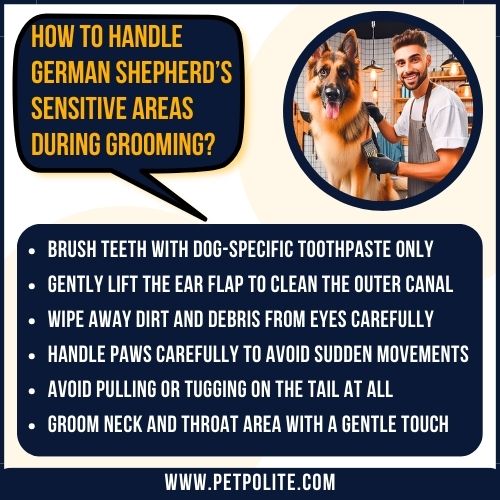

German Shepherds may be sensitive around certain areas like their neck, tail, paws, and ears.
Be extra gentle when grooming these areas and watch for signs of discomfort.
If your dog becomes aggressive, take a break and try again later.
6. Bathe Your Dog:
When it’s time for a bath, use lukewarm water and dog-friendly shampoo. Avoid getting water in your dog’s ears and eyes.
Speak calmly and reassure your dog throughout the bath.
Rinse thoroughly to remove all shampoo residue and follow with a conditioner if needed.
After the bath, use towels to dry your dog gently. You can also use a dog-friendly blow dryer on a low, cool setting if your dog tolerates it.
Make sure your dog is completely dry to prevent skin irritation.
7. Trim Nails:
If your dog allows it, trim its nails carefully using dog nail clippers or a grinder.
Be cautious not to cut too close to the quick, as this can cause pain and bleeding.
If your dog is very aggressive about nail trimming, consider having a professional do it.
Here’s a video guide to help you trim your aggressive German Shepherd’s nails.
8. Clean Ears and Eyes:
Gently clean your dog’s ears with a vet-approved ear cleaner and cotton balls, avoiding the ear canal to prevent damage.
Similarly, use a damp cloth to wipe away any discharge, dirt, or tear stains from the eyes, working from the inner to the outer corner to prevent spreading debris.
It helps prevent infections, reduce irritation, and keep your dog’s ears and eyes clean and healthy.
9. Take Breaks:
Take a break if your German Shepherd becomes stressed or aggressive during grooming!
It’s essential to prioritize their emotional well-being and safety. Let them calm down, then try again when they’re more relaxed.
It’s better to have multiple short, successful grooming sessions than one long, stressful one.
How To Handle Aggression During Grooming?
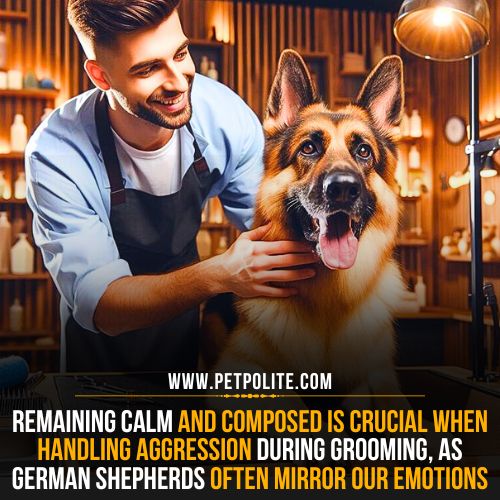

1. Establish Trust and Respect:
Build a strong bond with your German Shepherd based on trust and respect. Spend quality time together doing activities they love, like playtime and obedience training.
During grooming, use calm and reassuring body language to show your dog you’re not a threat.
2. Practice Desensitization:
Gradually get your German Shepherd used to the sensations and sounds of grooming. Start with short sessions and increase the duration over time.
Pair grooming activities with positive rewards to help your dog associate them with pleasant experiences.
3. Use Gentle Handling Techniques:
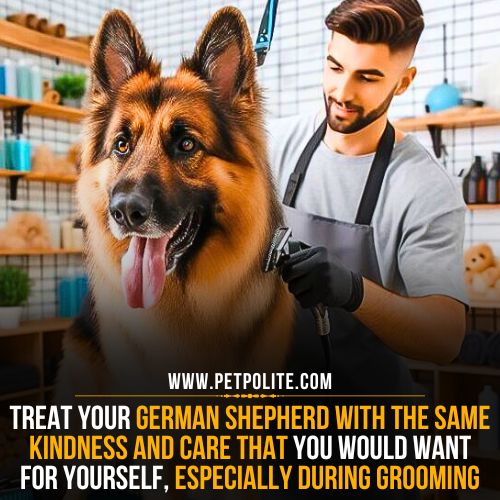

Handle your German Shepherd with care and gentleness during grooming. Avoid forceful restraint or punishment, as this can make things worse.
Use slow movements, making sure your dog feels safe and secure throughout the process.
4. Seek Professional Help if Needed:
If your German Shepherd’s aggression during grooming persists, don’t hesitate to seek help from a professional dog trainer or behaviorist.
They’ll provide personalized guidance to develop a tailored behavior modification plan.
Here are some useful tips to handle different aggressive behaviors in your GSD during grooming:
| Aggressive Behavior | How To Handle |
|---|---|
| Growling or Snapping | – Stop grooming immediately – Let the dog calm down – Gradually resume grooming with a gentle touch |
| Pulling Away | – Go at the dog’s pace – Use positive reinforcement (treats, praise) – Desensitize the dog to grooming tools |
| Raising Hackles | – Use calming signals (soft voice, gentle touch) – Avoid direct eye contact – Reward calm behavior |
| Biting or Nipping | – Stop grooming immediately – Let the dog calm down – Use a muzzle or consult a professional |
| Struggling or Squirming | – Use gentle, secure restraint – Provide regular breaks – Make grooming a positive experience |
How Do Groomers Deal With Aggressive German Shepherds?
Dealing with an aggressive German Shepherd during grooming can be challenging, but professional groomers have developed effective strategies to handle such situations.
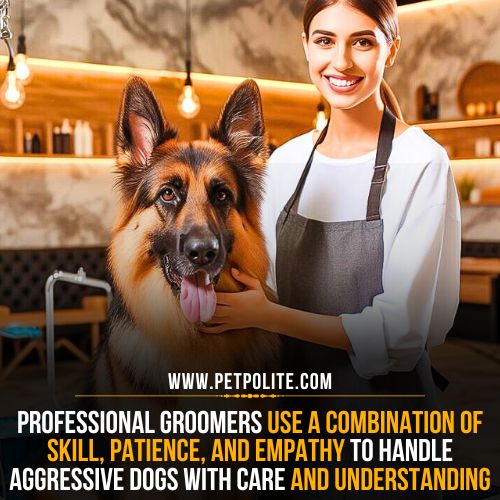

Here’s how they manage it:
1. Building Trust and Rapport:
The first step groomers take is to build trust with your German Shepherd. They spend time interacting with your dog before starting the grooming process.
2. Using Positive Reinforcement:
Groomers use positive reinforcement techniques, such as treats and praise, to create a positive association with grooming.
3. Calm and Gentle Handling:
Groomers are trained to handle dogs calmly and gently. They use slow, deliberate movements to avoid startling your dog.
It helps keep your German Shepherd relaxed and minimizes aggressive reactions.
4. Creating a Calm Environment:
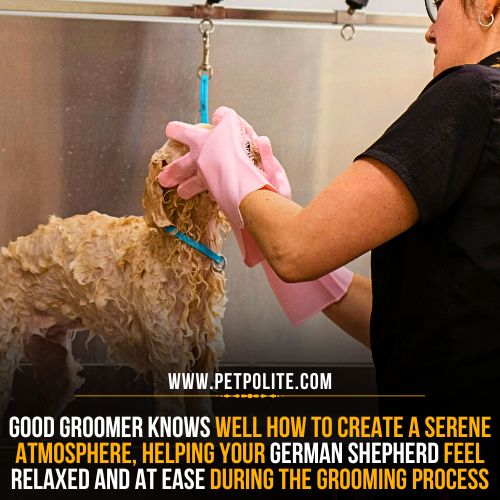

They keep the grooming environment calm and quiet to reduce stress. Soft music, pheromone diffusers, and a serene atmosphere can help calm an anxious or aggressive dog.
5. Desensitization and Counterconditioning
Groomers use desensitization and counterconditioning to help aggressive German Shepherds feel comfortable during grooming.
Desensitization means introducing grooming tools and processes gradually. Counterconditioning associates grooming with positive experiences like treats and praise.




“Counterconditioning helps your dog learn a new behavior when faced with something that causes fear or anxiety. It’s used alongside desensitization to help your dog feel calm and confident.”
Source: HoundTherapy.com
6. Safety Measures:
Safety is a top priority for groomers. They use tools like muzzles and grooming loops only when necessary and always ensure they are used correctly and comfortably.
This protects both the dog and the groomer from potential harm.
7. Collaboration with Owners:
Professional groomers often collaborate with dog owners to develop a grooming plan that works best for the dog.
They may suggest at-home grooming practices to help your dog get used to being handled and to make professional grooming sessions smoother.
Conclusion:
Grooming an aggressive German Shepherd can be challenging, but it is manageable with the right techniques and patience.
By gradually introducing grooming tools, starting with short sessions, handling sensitive areas with care, and using positive reinforcement, you can make the grooming experience more comfortable.
Remember to take breaks when needed and maintain a calm environment to help your dog feel more at ease.
Following these steps on how to groom an aggressive German Shepherd will help you build a positive grooming routine for both you and your dog.
Frequently Asked Questions:
How to groom an aggressive German Shepherd’s face?
Start by creating a calm environment and introducing tools slowly. Use a muzzle if necessary, brush gently, and reward good behavior. Taking breaks when needed ensures a positive experience.
How to groom an aggressive German Shepherd at home?
To groom an aggressive German Shepherd at home, build trust and use positive reinforcement techniques. Gradually introduce grooming tools, associating them with treats and praise. Work at your dog’s pace.
How to groom a German Shepherd that bites?
For a German Shepherd that bites during grooming, safety is paramount. Seek professional guidance and use desensitization techniques. Prioritize patience and caution to ensure a positive grooming experience.
How to cut an aggressive German Shepherd’s nails?
To trim nails on an aggressive German Shepherd, prioritize safety. Seek professional guidance or use a muzzle if necessary. Gradually desensitize the dog to nail trimming and reward calm behavior. Consider sedation for extreme cases.
How do I immobilize my German Shepherd for grooming?
To immobilize your German Shepherd for grooming, use a grooming table equipped with a sturdy harness or leash attachment to secure them safely. Alternatively, enlist a trusted helper to assist in gently restraining your dog while you groom.
Can grooming help reduce aggression in German Shepherds?
Yes, grooming can reduce aggression in German Shepherds by providing positive interactions, identifying discomfort, and reinforcing good behavior. However, professional guidance may be needed for underlying issues.
Resources Used For Research:
- A behaviour test on German Shepherd dogs: heritability of seven different traits – Science Direct
- Genetic dissection of complex behaviour traits in German Shepherd dogs – National Library Of Medicine
- Dog Groomer’s Manual: A Definitive Guide to the Science, Practice and Art of Dog Grooming: A Book by Sue Gould
- Predatory aggression in a German Shepherd dog – Science Direct